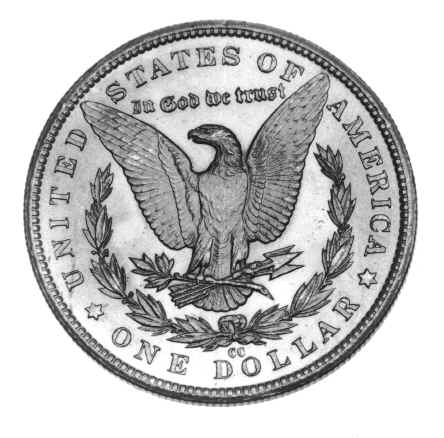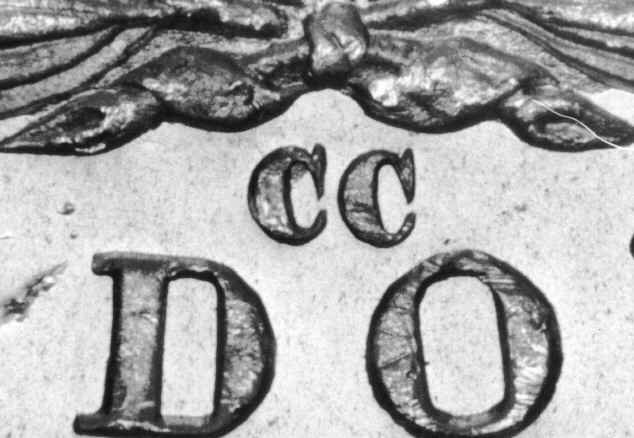
The Comstock Lode Morgan Dollar
The largest silver find in US history leaves a
tangible legacy
After gold was discovered in
California in 1848, a stream of treasure seekers flowed to the west coast from around the
world. Each was convinced they were going to strike it rich---and many did. In just a few
short years San Francisco grew from a sleepy berg to a bustling city teaming with new
wealth.
Of course, not everyone struck it rich. Only a few
years after mining began most of the gold in California had been found, forcing miners to
cross over the high Sierra in search of treasure---treasure which would prove to be larger
even that that found in California.
 Virginia City Nevada |
After years of grueling work, in the late 1850's prospectors
discovered mineable amounts of silver down the eastern slopes of the mountains in Nevada.
Soon more prospectors swamped to the area. Virginia City Nevada sprang up, first as a a
tent city, then as a real one with permanent buildings. As more and more treasure seekers
flocked into the area it grew rapidly into a classic boomtown. But even though men were pulling out respectable amounts of silver from
the hillsides around the city, there were hints---such as the fact that after a torrential
downpour someone decided to assay the mud---and found it was worth $2,000 a ton---that
somewhere nearby lay a much larger ore body---the mother lode. |
The Comstock lode
 Miner at work in the Comstock lode |
Prospectors searched and searched, and, finally, while digging
between two other claims, a small silver vein was found. At first it looked like many
others that had led to nothing, but, as the miners followed the vein deeper into the
mountainside, it grew to be a foot wide--then 10 feet wide, then twenty---and finally the
ore body seemed to be as large as a mountain itself. The
silver find was named the Comstock lode, and as it was mined it produced as much as
$8,000,000 worth of silver per month---at a time when a dollar was a considerable amount
of money.
A political boondoggle
Although the Comstock lode made men rich, the vast amount of
silver flowing out of Nevada depressed silver prices worldwide to their lowest levels in
history. There was so much silver, in fact, that many countries (including the US) debated
whether or not silver should continue to be money. This debate sent a chill wind up and
down the hills of Virginia City---if silver was demonetized the mines would shut down and
Virginia City would become a ghost town. |
The rugged men and women of Nevada were determined to fight this
outcome, and, as in an old west poker game---they had a few trump cards---cards which they
proceeded to play.
 Miners rolling ore carts out of the
mine |
A little something up the sleeve When the United States Mint was established in 1792, Congress had
instituted the policy of Free Coinage of Silver---any citizen could bring as much silver
as he or she wanted to into the Mint, and the government would strike the silver into
coins. This policy was never a problem until the Comstock lode was discovered---but as
rivers of silver began to flow out of Nevada to the Mint, many in Congress demanded a halt
to the Free Coinage system. By 1878 the situation was coming to a head---and it didn't
look promising for the silver interests---after all, the government was losing over ten
cents on every dollars worth of silver being struck into coins! |
 The Gould and Curry
reduction works, Virginia City |
Enter the Silver Lobbyists. Lincoln had made Nevada a State in
1864. Even though it had no population to speak of, it did have two senators---and you can
probably guess their position on silver. In a negotiation with Eastern interests who
wanted higher tariffs, a compromise was reached. Instead of halting the coinage of silver,
Congress did just the opposite---they passed higher tariffs and a law forcing the Mint to
produce millions of silver dollars every month---resulting in a huge profit to the mine
owners in Nevada. |
A new Silver Dollar---and a new Mint
In order to help comply with the law, a new Mint was established
in Carson City, Nevada---just an ore cart away from the mines---and a new silver
dollar---The Morgan Dollar---was designed and quickly put into production.
 The obverse of
the 1883 CC Morgan Dollar |
 The reverse of
the Carson city Silver Dollar |
To identify coins produced at the Carson City Mint, a
distinctive mint mark was placed beneath the eagle on the reverse of the coin---two
"C's"---standing for Carson City. The managers of the Mint may have not realized
it at the time, but the distinctive two letter mint mark ended up being the only one of
it's kind in US coinage history.

A close-up of the famous "CC" mint mark |
The Carson City Mint was small, and even though it was the
closest Mint by far to the ore bodies, it never produced huge numbers of silver dollars,
and many of the ones it did make were released immediately into circulation in the west. Alas, the Comstock lode played out---and Virginia City did become a
ghost town. With the flow of silver from the mines reduced to a trickle, there was no
longer a need for a Mint in the area. Only a few short years after it was established, the
Carson City Mint was closed forever. |
Millions of Silver Dollars Melted.
During World War I, Congress needed huge amounts of silver
bullion to lend to England, so it passed the Pittman Act, which resulted in the melting of
millions of silver dollars. No regard was paid to the unique status of the double lettered
mint marked coins from Carson City---everything was tossed into the melting pot.
Today, many silver dollars produced at the Carson City Mint are
rare and expensive---some selling for many thousands of dollars.
Luckily, some uncirculated Carson City Silver Dollars stored in
government vaults escaped both the World War I meltdown and a smaller one during World war
II. As a result, there are still some of these unique coins available---but no one can say
for how much longer.
HOME
TOP
BACK
NEXT
© 1998 CollectSource



